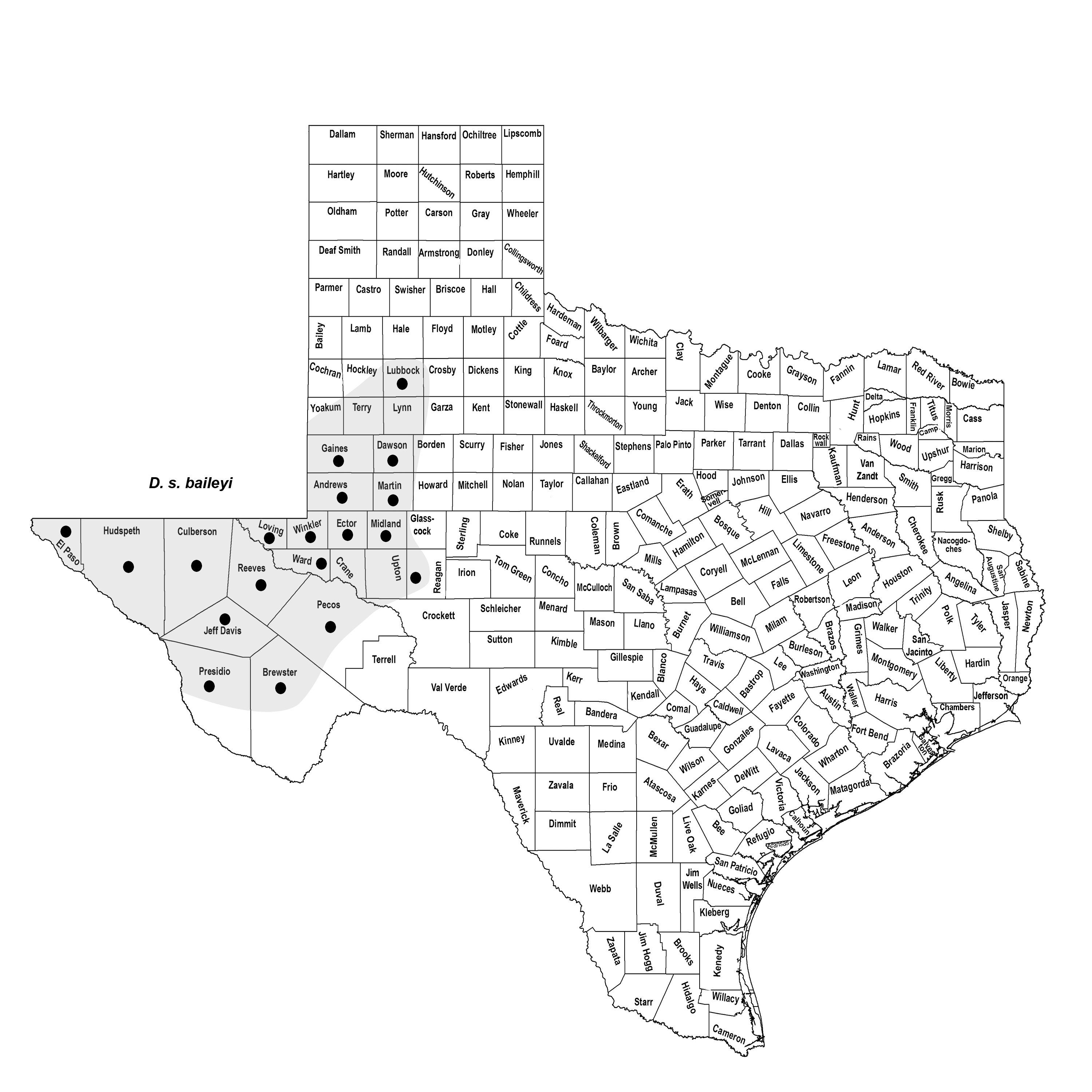BANNER-TAILED KANGAROO RAT
Dipodomys spectabilis Merriam 1890
Order Rodentia : Family Heteromyidae
DESCRIPTION. A large, four-toed, long-tailed kangaroo rat; tail about 1.5 times as long as head and body, with a distinct white tuft at end; hind foot broad and usually >50 mm in length; upperparts dark buff; black facial markings and stripes on tail conspicuous. Dental formula: I 1/1, C 0/0, Pm 1/1, M 3/3 × 2 = 20. Averages for external measurements: total length, 350 mm; tail, 210 mm; hind foot, 53 mm. Weight, 115 g.

DISTRIBUTION. Occurs in western and central Trans-Pecos region and east to Reagan County and north to Lubbock County.

SUBSPECIES. Dipodomys s. baileyi.
HABITS. This large kangaroo rat appears to be limited in distribution to sparsely brush-covered slopes and low hills at elevations usually between 1,200 and 1,500 m. In the Trans-Pecos it is most abundant on slopes covered with scattered, mixed stands of creosote brush and acacias on hard and moderately gravelly soil. It has never been encountered in loose soils or drift sands.
The large complex mounds of these kangaroo rats are unmistakable evidence of their presence. On soils that will pack and withstand weathering, the mounds may be over 1 m in diameter and 9–130 cm in height, but on sandy soils they are less obvious. As many as a dozen openings admit the rat to the complex system of galleries and side branches that lead to the feeding areas. In addition, subsidiary burrows or duck-ins are relied on for protection. Usually only one rat occupies each den. In a manner similar to woodrats, D. spectabilis creates pathways, often clearly visible for several meters, from the mound to foraging areas. Burrows are occasionally constructed atop buried pipelines where indurated caliche has been loosened and presumably provides easier digging.
These rats are exceedingly fleet and agile, and to catch them at night by running them down is no mean feat. Once in the hand, they can inflict painful wounds with their teeth and claws unless handled carefully.
Their food is almost entirely plant materials, with seeds ranking high on the list. Green vegetation is eaten on occasion. Large quantities of food are stored in the dens to carry them over the periods of scarcity. Stores from a fraction of a gram to well over 5 kg have been found. In 1922, Charles Vorhies and Walter Taylor listed 13 species of grass and 29 other plants that contribute to their diet. Needlegrass, grama grass, mesquite, and a composite plant were the most important foods. The banner-tailed kangaroo rat seldom drinks, even if water is present.
The breeding season begins in January and continues into August. The young begin to
appear in March, sometimes as early as February, and nearly full-grown juveniles are
common by April. The gestation period is not known. The young are naked at birth,
and the eyes and ears are closed; the number per litter varies from one to three but
usually is two. They are born in an underground nest composed of fine vegetation and
chaff refuse from the food. Nest chambers vary in size from 15 × 20 cm to 20 × 25
cm.
Known natural predators include badger, swift fox, bobcat, and coyote. Other animals also probably prey on them.
Banner-tailed kangaroo rats have little economic impact. In periods of drought, they may do some damage to rangelands by gathering and eating grass seeds, but they are not a major problem
POPULATION STATUS. Uncommon. Banner-tailed kangaroo rats remain common throughout their range in Texas. In some places, they are locally abundant.
CONSERVATION STATUS. The IUCN lists the banner-tailed kangaroo rat's status as near threatened; however, it does not appear on the federal or state lists of concerned species. Degradation or loss of grassland habitat could severely affect its status. This is a species that should be carefully monitored in the future.
From The Mammals of Texas, Seventh Edition by David J. Schmidly and Robert D. Bradley, copyright © 1994, 2004, 2016. Courtesy of the University of Texas Press.
Natural Science Research Laboratory
-
Address
Museum of Texas Tech University, 3301 4th street, Lubbock, TX 79409 -
Phone
806.742.2486 -
Email
nsrl.museum@ttu.edu

